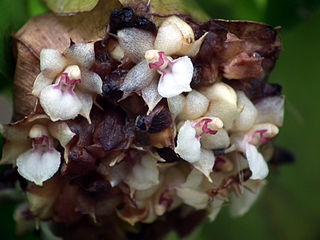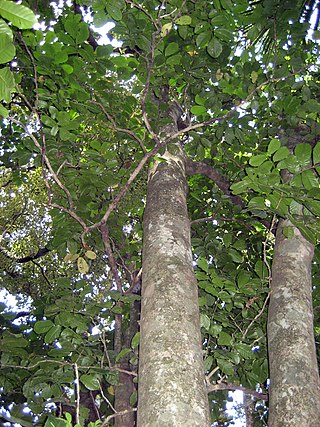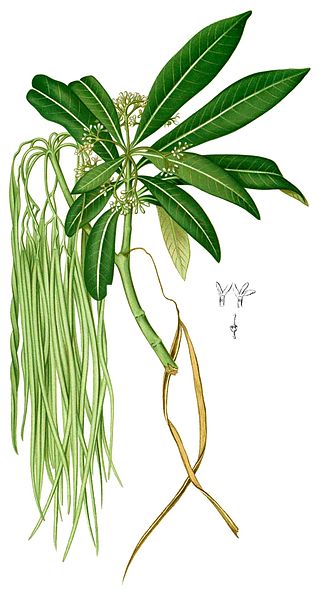
Malesia is a biogeographical region straddling the Equator and the boundaries of the Indomalayan and Australasian realms, and also a phytogeographical floristic region in the Paleotropical Kingdom. The original definition by the World Geographical Scheme for Recording Plant Distributions included Papuasia, but this was split off in its 2001 version.

The Solomon Islands rain forests are a terrestrial ecoregion covering the Solomon Islands archipelago.

Agrostophyllum is a genus with about ninety species from the orchid family (Orchidaceae). The genus name is derived from the Greek words agrostis ("grass") and phyllos ("leaf"), referring to the grass-like appearance of the leaves of some species.

Canarium is a genus of about 120 species of tropical and subtropical trees, in the family Burseraceae. They grow naturally across tropical Africa, south and southeast Asia, Indochina, Malesia, Australia and western Pacific Islands; including from southern Nigeria east to Madagascar, Mauritius, Sri Lanka and India; from Burma, Malaysia and Thailand through the Malay Peninsula and Vietnam to south China, Taiwan and the Philippines; through Borneo, Indonesia, Timor and New Guinea, through to the Solomon Islands, Vanuatu, New Caledonia, Fiji, Samoa, Tonga and Palau.

Dysoxylum is a flowering plant genus of trees and shrubs from the mahogany family, Meliaceae.

Ptychosperma is a genus of flowering plant in the family Arecaceae. Most are native to Australia and/or New Guinea, with a few in the Solomon Islands and in Maluku Province of eastern Indonesia. Some have been cultivated abroad as house or garden plants, and reportedly naturalized in certain regions

Myristica globosa is a species of plant in the family Myristicaceae. It is found in parts of Melanesia and Australia.

The Solomon Islands (archipelago) is an island group in the western South Pacific Ocean, north-east of Australia. The archipelago is in the Melanesian subregion and bioregion of Oceania and forms the eastern boundary of the Solomon Sea. The many islands of the archipelago are distributed across Papua New Guinea and Solomon Islands (country). The largest island in the archipelago is Bougainville Island, which is a part of the Autonomous Region of Bougainville along with Buka Island, the Nukumanu Islands, and a number of smaller nearby islands. Much of the remainder falls within the territory of Solomon Islands and include the atolls of Ontong Java, Sikaiana, the raised coral atolls of Bellona and Rennell, and the volcanic islands of Choiseul, Guadalcanal, Makira, Malaita, New Georgia, the Nggelas, Santa Isabel, and the Shortlands. The Santa Cruz Islands are not a part of the archipelago.

Eurycentrum is a genus of flowering plants from the orchid family, Orchidaceae. It contains 7 known species, native to New Guinea and to certain islands of the Pacific.
- Eurycentrum amblyocerasSchltr. - New Guinea
- Eurycentrum atrovirideJ.J.Sm. - New Guinea
- Eurycentrum fragransSchltr. - New Guinea
- Eurycentrum goodyeroidesRidl. - New Guinea
- Eurycentrum monticolaSchltr. - New Guinea
- Eurycentrum obscurum(Blume) Schltr. in K.M.Schumann & C.A.G.Lauterbach - New Guinea
- Eurycentrum salomonenseSchltr. in K.M.Schumann & C.A.G.Lauterbach - Solomons, Vanuatu, Santa Cruz Islands

Badusa is a genus of flowering plants in the family Rubiaceae. It was described by Asa Gray in 1860. The genus is native to the Philippines (Palawan), New Guinea, and some islands of the West Pacific.
Canarium vitiense is a rainforest tree species, of the plant family Burseraceae, growing naturally in Fiji, the Solomon Islands, Samoa, Tonga, New Guinea, Bismarck Archipelago, Admiralty Islands, Louisiade Archipelago, Torres Strait Islands and in lowland north-eastern Queensland, Australia.

Myxopyrum is a plant genus native to India, southern China, Southeast Asia and New Guinea. There are at present 4 recognized species:

Decaspermum is a genus of the botanical family Myrtaceae, first described as a genus in 1776. It is native to China, Southeast Asia, Queensland, and various islands of the Pacific Ocean.

Kilu Cave is a paleoanthropological site located on Buka Island in the Autonomous Region of Bougainville, Papua New Guinea. Kilu Cave is located at the base of a limestone cliff, 65 m (213 ft) from the modern coastline. With evidence for human occupation dating back to 30,000 years, Kilu Cave is the earliest known site for human occupation in the Solomon Islands archipelago. The site is the oldest proof of paleolithic people navigating the open ocean i.e. navigating without land in sight. To travel from Nissan island to Buka requires crossing of at least 60 kilometers of open sea. The presence of paleolithic people at Buka therefore is at the same time evidence for the oldest and the longest paleolithic sea travel known so far.

Cephalomanes atrovirens is a species of fern in the family Hymenophyllaceae. The genus Cephalomanes is accepted in the Pteridophyte Phylogeny Group classification of 2016, but not by some other sources. As of October 2019, Plants of the World Online sank the genus into a broadly defined Trichomanes, while treating the subtaxa of this species as the separate species Trichomanes acrosorum, Trichomanes atrovirens, Trichomanes boryanum and Trichomanes kingii.

Canarium indicum, known as galip nut, is a mainly dioecious tree native in eastern Melanesia. It is usually found in rainforests, secondary forests, old garden areas, around villages and settlements. It is also used as a shade tree, as a windbreak and in agroforestry. Canarium is important in the world food system as it can be used as a food and timber source, in traditional medicine, intercropping and agroforestry.
Symplocos cochinchinensis is a species of flowering plant in the sapphire-berry family Symplocaceae, native to tropical and subtropical Asia. The widespread Symplocos cochinchinensis subsp./var. laurina is now considered a synonym of Symplocos acuminata.

Alstonia spectabilis, commonly known as bitterbark, yellowjacket, milky yellowwood, leatherjacket, jackapple, hard milkwood or hard cheesewood, is a medium-sized species of tree in the dogbane family. It is native to eastern Malesia, Melanesia and northern Australia.
Atuna excelsa is a species of flowering plant in the family Chrysobalanaceae, native to Thailand to the western Pacific.
Myristica inutilis is a species of flowering plant in the nutmeg family, Myristicaceae. It is a tree native to the South Pacific, ranging from New Guinea through the Bismarck Archipelago and Solomon Islands to Vanuatu, Wallis and Futuna, and the Samoan Islands. It is not native to Fiji, but may be present in Tonga.















